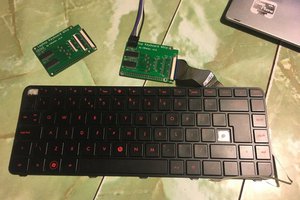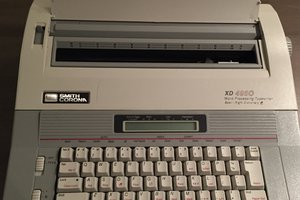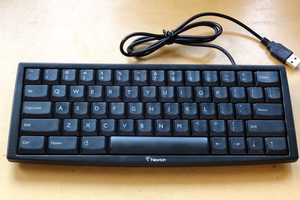Orao's keyboard input works by shorting connections between 6 data lines (D4-D7) and 10 address lines (A0-A9). When a key is pressed, the connection is shorted between corresponding lines to input a key press. I.e., to type "A", the key short address line A7 and data line D5. MT8816 is an analog switch relay. It contains a 8 x 16 array of crosspoint switches along with a 7 to 128 line decoder and latch circuits. The 8 lines are labeled Y0-Y7, and the 16 lines are labelled X0-X15. MT8816 can connect any Y line with any X line, and it can make multiple concurrent connections. Y1 to Y6 lines are connected to Orao's keyboard connector pins 1-6 (data lines D4-D7), and X0 to X9 are connected to Orao keyboard connector pins 7-16 (address lines A0-A9).
MT8816 connections are selected by seting bits on address inputs AX0-Ax3 and AY0-AY3. The addresses are defined in the MT8816 datasheet in Table 1 - Address Decode Truth Table on page 11. Address inputs are connected to Arduino digital I/O pins 31-37. Arduino uses PS2KeyAdvanced library to read keycodes from the connected PS/2 keyboard, connected to digital I/O pins 2 and 3. When a key is pressed (i.e. 32833 for A), Arduino sets the bits on the address inputs (1100101 for A), raises MT8816 data pin to save it to memory, raises and lowers strobe, holds for 22ms, then lowers data and raises reset. This makes the connection between A7 and D5 on the Orao.
Due to the physical difference between modern, Model-M compatible keyboards and Orao's keyboard, I've made the following key placement decisions:
- Insert key is used for * : Orao key
- Home key is used for / ? Orao key
- Backspace is used as left arrow key in addition to the actual left arrow key because it effectively works as backspace
This project was inspired by Marko Šolajić's galaksija-keyboard-interface project and the C64-keyboard project
orao_keyboard is still a prototype, and my next step is to design and manufacture it as PCB.
 Vlado Vince
Vlado Vince
 David Boucher
David Boucher
 Arya
Arya
 Will
Will
 Dan Julio
Dan Julio